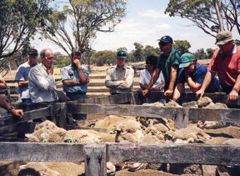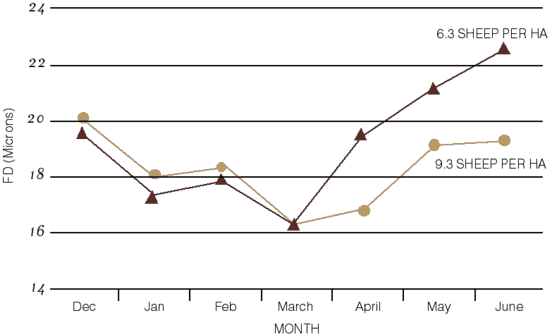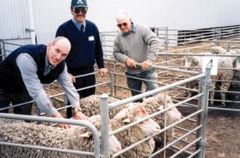
Increasing grazing pressure of young Merino sheep can lead to dramatic increases in profitability, new research is showing. For more than three years, AgWEST’s Chris Oldham has been working with a group of farmers to better understand the secrets of healthy wool balance sheets for young sheep.
UNTIL RECENTLY, it was common practice for wool growers to encourage their young sheep to grow as big and as fast as possible. But the downside of large sheep with free access to generous feed is that the fibre diameter of their wool blows out with their waistlines. This leads to smaller quantities of less valuable wool from each hectare—high clean fleece per head but higher mean fibre diameter, lower staple strength and less wool per hectare.
Dr Chris Oldham from AgWEST and Wagin farmer
Phil Blight check out some hoggets. In the recent
research both quantity and quality of wool has been
improved by managing pasture. Phil Blight is one
of Wagin’s co-operating farmers.
The most important number in the balance sheet is income per hectare. More income can be achieved by increasing the grazing pressure in winter and spring which results in more and better quality wool, through reducing the fibre diameter while increasing staple strength.
The secret to managing staple strength is to keep fibre diameter variation to a minimum. A ‘flatter’ profile will be stronger than one of similar average fibre diameter but with wider variation over the season. Rapid growth of animals, particularly after a good early break to the season in Mediterranean climates, is linked to higher fibre diameters and greater variation in fibre diameter along the length of the staple, therefore lower staple strength.

Dr Chris Oldham and famers looking at sheep
during a field day.
For lambs born between April and July, a December bodyweight of 35 kg is a reasonable target. Farmers should then aim for a slow but gradual bodyweight increase from weaning to the following spring, Dr Oldham suggests.
On a co-operating farm at Boddington, south of Perth, one group of weaners was run at the normal stocking rate of 6.3 sheep per hectare and another at 9.3 sheep per hectare, from just before the opening rains in mid-March. Restricting intake of the new green feed flattened the fibre diameter profile as shown in Figure 1.

Figure 1:
Effect of controlling intake of green pasture from March on wool fibre diameter profile in two
commercial flocks of young sheep at Boddington WA. The flatter fibre diameter profile of the sheep
stocked at higher rates results in higher staple strength.
Clean fleece weight per head was higher on the control flock at 3.4kg compared with 2.8kg at the higher stocking rate, but production per hectare was 5kg higher from the high stocking rate flock, increasing returns by $31 per hectare.
The fibre diameter fell from 20.7 to 19.2 microns at the high stocking rate while staple strength actually increased from 27 N/ktex to 33 N/ktex. This resulted in quality gains of $29 per hectare.
Overall, the increase in gross wool income per winter-grazed hectare rose by 46 per cent from $128 to $188.

Dr Chris Oldham (left), geneticist Dr Johan Greeff (centre)
and a local farmer at the Great Southern Agricultural
Research Institute Katanning, WA
Detailed results are limited to only 10 flocks for one year with spring-shorn sheep but the co-operating farmers are very enthusiastic about the gains obtained largely from increasing stocking rate between March and shearing.
In the past, adult wethers were used to help the cropping program by controlling pasture growth before seeding. However, in recent years the number of adult wethers has been dramatically reduced and it is not cost effective to restrict the feed intake of lambing ewes. Now managers are seriously considering using young sheep to fill the weed control function.
Summary:
- The largest influence on the wool cheque of growers is the weight of clean wool produced per hectare.
- In many wool growing areas there is excess feed in the winter/spring but not enough in the summer/autumn.
- Rapid weight gains in young sheep lead to blow-out in fibre diameter and reduced staple strength.
- Increasing stocking rate over winter can substantially increase returns by increasing both quality and quantity of wool produced.
In this issue of The Wool Press: